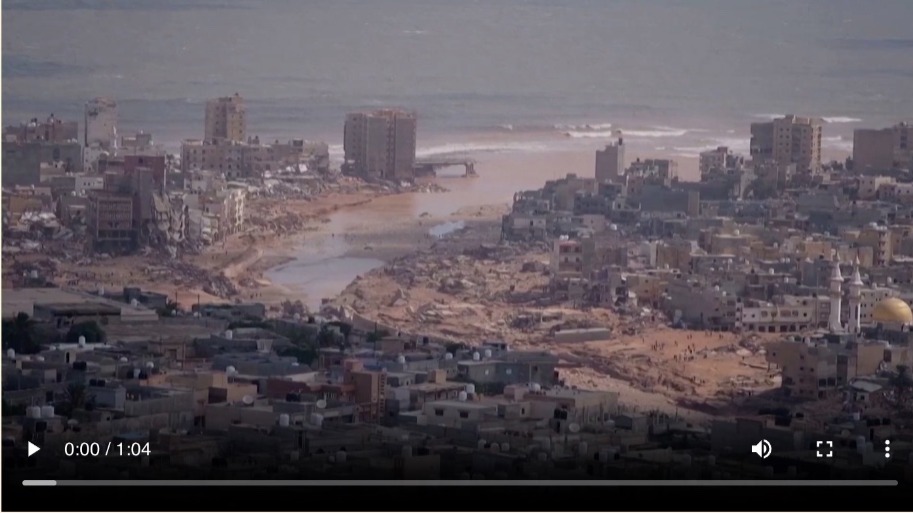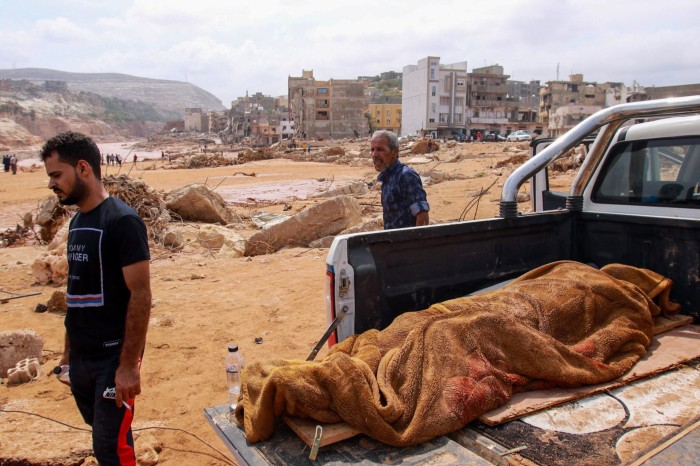As Storm Daniel swept across the Mediterranean Sea on a collision course with Libya, officials in the east of the country began to issue conflicting warnings. Some residents in the coastal city of Derna were ordered to stay in their homes, while others were told to evacuate.
So when the storm struck, bringing with it torrential rains and ferocious winds, there was no time to prepare as two ageing dams holding back the river in the hills above the city suddenly collapsed. Torrents of floodwater ripped through Derna, washing buildings, roads, cars and people out into the open sea and killing more than 5,000 people.
Almost a week on, the recriminations are being felt across the divided country that has endured more than a decade of chaos and conflict. This has left its infrastructure in decay and its institutions weak and hollowed out.
While experts have long warned that Derna’s dams were liable to burst, the authorities have been quick to absolve themselves.
Aguileh Saleh, who heads the eastern-based parliament, told Libyans that no one was to blame. “God wills and acts. Don’t say ‘if only we’d done this or that’,” he told an emergency session of parliament. “What happened in our country was a natural catastrophe.”
Ahmed Al-Mismari, spokesman for the warlord Khalifa Haftar, who controls the eastern part of Libya that includes Derna, said the disaster was “completely unexpected”, despite meteorological warnings of possible floods that were issued before the storm made landfall. “It happens in all countries,” he added at a press conference.

Only Libya is not like other countries. The vast north African state with a population of 6mn sits on the continent’s largest proven oil reserves. It has natural riches to rival the United Arab Emirates, but its citizens struggle to access basic services, while a divided and ever-feuding political elite have sliced up the country into personal fiefdoms.
The failures even to maintain Derna’s dams — for a small fraction of what Haftar, for example, is estimated to have spent on the Russian and Sudanese mercenaries that he relies on to prop him up — have left Libyans seething.
“All should resign,” prominent journalist Khalil Al-Hassi said of the officials who he and many others Libyans believe are culpable.
“We’re bringing corpses out of the sea with nets as if they’re fish. It’s been 14 years with those people who caused this catastrophe. We don’t trust their investigations, their judiciary. We don’t trust anything from this failed Libyan state,” he said in a television interview.
The flood washed away bridges and destroyed a 10 sq km swath of the ancient city, which had seen Greek, Roman and Islamic rule.

© Reuters
Scenes of devastation in Derna as search and rescue operations continue
Libyan officials have given wildly conflicting tolls, but at least 5,500 people have died so far, with others saying as many as 20,000 may have perished. They are being buried in mass graves, and numbers are likely to increase as more bodies are recovered.
“This isn’t the result of the storm. It’s the direct result of governance and cronyism of officials over the years, with the dams exploding under that weight,” said Emadeddin Badi, a Libyan researcher and senior analyst with Global Initiative.
“Storm Daniel was just the match” that lit the fuse, he added. “It’s the political elites and security authorities that set the stage for Derna to become the crime scene that it is today.”
The lead-up to the disaster underscored the state’s dysfunction. An academic study last year published by a Libyan university journal warned of fissures in the dams and “disastrous consequences” should they fail.
As Storm Daniel approached, authorities in Derna, led by the mayor, who is a relative of Aguileh Saleh, told some people to leave and ordered a curfew for others.

Survivors have struggled to put the extent of the calamity into words. “It’s impossible to describe,” said one, from a hospital bed in a video posted on social media. “Bodies were floating on the water, cars floated by, girls were screaming. It lasted an hour or an hour and a half, but it felt like more than a year.”
The dams were constructed in 1970s with the help of a Yugoslavian company, when Libya was ruled by the dictator Muammer Gaddafi. Only a couple of years before his overthrow in 2011, his government contracted a Turkish firm to conduct repairs, but the work was apparently called off due to the chaos surrounding the civil war that ended with his Nato-backed ouster.
Since then, Libya has seen a succession of conflicts, including a devastating battle to retake Derna from al-Qaeda-linked militants that ended in 2019. Months later, Haftar marched his Libyan National Army on the capital Tripoli to overthrow the internationally recognised government there, drawing in military intervention by Turkey, the UAE and Russia’s Wagner mercenary group.
A 2020 ceasefire was meant to be followed by elections. But the new government in Tripoli, which was intended to be transitional, has clung to power and lobbied against an election, while Haftar has kept the east.
They are firmly entrenched, playing both patron and proxies to militiamen and political allies in their fiefdoms, and foreign powers such as Turkey, which still has a military presence, and Russia, whose mercenaries remain in the east.
Despite so many players competing for power and influence, none gave much thought to Derna’s residents or its crumbling dams — until it was too late.
A former western diplomat who worked in the country spoke of huge public anger in Libya, adding: “I hope it’s enough to throw out all those thugs.”
Cartography by Steven Bernard







